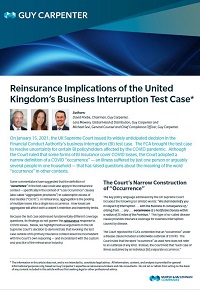Authors: David Priebe, Chairman; Lara Mowery, Global Head of Distribution; Michael Sevi, General Counsel and Chief Compliance Officer
On January 15, 2021, the UK Supreme Court issued its widely anticipated decision in the Financial Conduct Authority’s business interruption (BI) test case. The FCA brought the test case to resolve uncertainty for certain BI policyholders affected by the COVID pandemic. Although the Court ruled that some forms of BI insurance cover COVID losses, the Court adopted a narrow definition of a COVID “occurrence” — an illness suffered by just one person or arguably several people in one household — that has raised questions about the meaning of the word “occurrence” in other contexts.
Some commentators have suggested that the definition of “occurrence” in the test case could also apply in the reinsurance context — specifically in the context of “Loss Occurrence” clauses (also called “aggregation provisions”) in catastrophic excess of loss treaties (“Cat XL”). In reinsurance, aggregation is the pooling of multiple losses into a single loss occurrence. How losses are aggregated will affect both a cedent’s retention and indemnity limits.
Because the test case addressed fundamentally different coverage questions, its findings do not govern the reinsurance response to COVID losses. Below, we highlight textual arguments in the UK Supreme Court’s decision to demonstrate that invoking the test case outside of its primary insurance context would be inconsistent with the Court’s own reasoning — and inconsistent with the custom and practice of the reinsurance industry.
The Court’s Narrow Construction of “Occurrence”
The key policy language addressed by the UK Supreme Court included the following (or similar) words: “We shall indemnify you in respect of interruption. . . with the Business in consequence of / arising from . . .any. . . occurrence of a Notifiable Disease within a radius of 25 miles of the Premises.” This type of so-called disease clause provides insurance coverage for business interruption caused by disease.
The Court rejected the FCA’s contention that an “occurrence” under a disease clause included a nationwide outbreak of COVID. The Court ruled that the word “occurrence” as used here does not refer to an outbreak of any kind. Instead, the Court held that “each case of illness sustained by an individual [is] a separate occurrence.”
In a critical paragraph, the Court explained that an outbreak of COVID cannot be an insurance “occurrence”:
A disease that spreads is not something that occurs at a particular time and place and in a particular way: it occurs at a multiplicity of different times and places and may occur in different ways involving differing symptoms of greater or less severity. Nor for that matter could an “outbreak” of disease be regarded as one occurrence . . . Still less could it be said that all the cases of COVID-19 in England (or in the United Kingdom or throughout the world) which had arisen by any given date in March 2020 constituted one occurrence. On any reasonable or realistic view, those cases comprised thousands of separate occurrences of COVID-19.
The Supreme Court agreed with the High Court’s reasoning that the “insured peril” is COVID whenever and wherever it occurs, and the peril is not limited to any particular occurrence or outbreak.
Must the Reinsurance “Event” Be Narrow As Well?
Many CAT XL treaties have Loss Occurrence definitions that allow for the aggregation of losses arising from “one event.” The following language is typical: “Loss Occurrence means the sum of all individual losses directly occasioned by any one disaster, accident or loss or series of disasters, accidents or losses arising out of one event.”
Based on the UK Supreme Court’s reasoning in the test case (especially the paragraph quoted above), it has been suggested that the “one event” for purposes of aggregating COVID losses cannot be the outbreak of COVID itself.
Context is Everything
The Court’s decision does not apply to the meaning of “occurrence” or “event” in the Loss Occurrence provisions of a CAT XL reinsurance contract. The Court itself stated that its narrow definition of “occurrence” was based on the context before it, namely the “interpretation which makes best sense of the [disease] clause” in the primary policies under review.
Thus, the Court was deciding whether insurers were liable under a primary BI disease extension—nothing more.
In a CAT XL contract, the question of which insured losses are reinsured is settled. The typical “Business Covered” section of a CAT XL establishes that it covers all property business and thus all BI losses (including non-damage BI extensions). In the CAT XL context, the term “event” does not limit the scope of the insured peril, but rather the extent to which insured losses may be aggregated for retention and limit purposes. The following chart summarizes this critical distinction:


